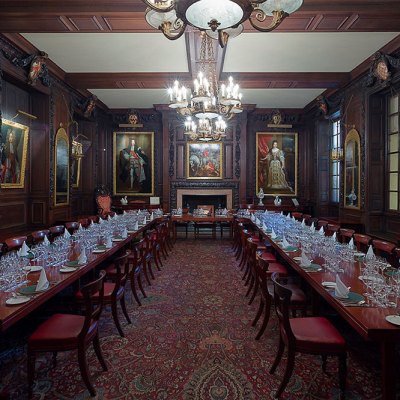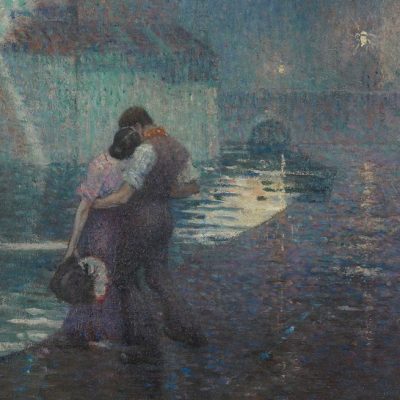Anthologies are rarely coherent and ‘The Big City’, an exhibition at the Guildhall which claims to celebrate ‘extraordinary artists who paint London on a huge scale’, has a hard time in justifying its aims – beyond that of showing some immense paintings in a relatively small and awkward space. Starting with an anteroom containing vast canvases showing key events in the City of London – the Diamond Jubilee service at St Paul’s in 1897, the Coronation Luncheon at the Guildhall on 12 June 1953, the Commonwealth Prime Ministers’ Banquet in 1969 – the exhibition confronts visitors with an array of ceremonial, in which the participants seem little more than mattress stuffing around the key figures. These were onerous commissions, as can be seen when contrasting Andrew Carrick Gow’s sprightly watercolour sketches and his leaden finished work depicting the Diamond Jubilee event. Yet judging from his self-portrait (in Aberdeen), Gow with his waxed moustaches was a man who enjoyed status.
The Commonwealth Prime Ministers’ Banquet, 13 January 1969 (1969), Terence Cuneo. Photo: © Guildhall Art Gallery, City of London Corporation; © the artist

These establishment artists of the 19th and 20th centuries were masters of their arcane art – none more so than Terence Cuneo (1907–96), a heroically industrious man who could, at will, switch focus from scenes of war, steam trains or big game to heavy-laden dining tables and massed dignitaries feasting in the lofty Gothic interiors of the Guildhall. The effect of these mobbed events on canvas is to make you crave solitude. A highly atmospheric painting by James Tissot, in which an unidentified pair of pensive elderly dignitaries in an open vehicle descend Ludgate Hill through a forest of flags, suddenly demonstrates what an artist of real quality could extract from such moments of ceremony. Yet for all the regalia and insignia Tissot included, the curators cannot supply any information beyond a putative date (c. 1879) to explain the significance of the occasion or the identity of Tissot’s subjects. That paucity of information is a serious, and repeated, failure in this exhibition. Who was ‘Robert M Swan’ who painted the dignitaries awaiting the arrival of Winston Churchill’s funeral procession on the cathedral steps in 1965? A key modern commission such as this can’t have been handed to an entirely spectral figure, and the quality of the image with its high viewpoint and sombre tones suggest a more-than-journeyman painter at work.
A Civic Procession Descending Ludgate Hill, London (c. 1879), James Tissot. Photo: © Guildhall Art Gallery, City of London Corporation

This is, in fact, a very odd exhibition. That dimensions were the deciding factor behind the selection has led to some strange neighbours on the walls. A view from 1789 of the annual river pageant from when the new Lord Mayor was sworn in adds a sense of place and time. Although only a copy, the Lord Mayor presenting his address to King Louis-Philippe at Windsor Castle in 1844 does intimate a world beyond London. The only extant original of this grim line-up, painted by Jean Alaux, hangs at Versailles.
A small section of ‘The Big City’ is devoted to ‘colossal landscapes’ – but with the exception of Johannes Vorstermans’ view from the 1670s of Greenwich back to the City, which shows the demolition of the Tudor Palace of Placentia immediately below, they are mostly bloodless, unpeopled accounts of the built scene in the later decades of the 20th century, panoramas of Clerkenwell or the view from the top of the Shell Centre, as the case may be. Only The Heart of the Empire, painted by the Danish artist Niels Moller Lund in 1904 offers an interpretation of the City of London that is both resonant and atmospheric – since we can see it as an epitaph.
Roman (1992–93), Jock McFadyen. Photo: © Guildhall Art Gallery, City of London; © artist

At times the exhibition feels like a disappointing house clearance sale. There are some contemporary paintings included in the selection. Among the best are by Jock McFadyen and David Hepher, who inject a sense of a wider, rougher, London – a place where people live, work, play and even misbehave. The latter’s vast canvases, arranged as a triptych, dominate the lower section of the gallery. (The artist made a gift of these works to the Guildhall, the largest in its recent history, in 2022.) For much of Hepher’s career he has been painting the tower blocks of Camberwell which form the immediate backdrop to his house and studio. But if the modernist estate is familiar, here rendered purposely repetitive, these works from 2013–2014 inject another element – a textural link to the subject matter. A scattering of graffiti covers and adds colour to the rough cast surface of the canvases, which have been built up with concrete in the mix.
It is the anonymity of these blocks, and yet their innumerable distinguishing marks, which attracts Hepher to the subject – ‘I just paint what is around me.’ These are the ultimate urban landscapes, unmediated. They suggest a disjointed echo to the society set-pieces, huge assemblies of anonymous, but chosen, individuals seated or standing at interminable events. Cheered by Hepher’s contribution, I began to search the walls for other archetypal 20th-century London artists; would there be a Leon Kossoff, perhaps showing Smithfield or Christ Church Spitalfields whipped into shadowy existence in deep impasto? But no. There are no loans to be seen, and little evidence of a curator to ask for them.
Gordon House, East Face (2013), David Hepher. Photo: © Guildhall Art Gallery, City of London Corporation; © the artist

Before leaving the Guildhall Art Gallery, I suggest you continue walking downstairs. Scarcely signalled is another huge event, well below. The Roman amphitheatre site excavated during the 1980s as part of building works in Guildhall Square opened to the public only in 2002 and so discreetly that visitors to the gallery can easily miss it.
As the City soars (and ‘The Big City’ exhibition pays no attention to the recent and pending very big additions to its skyline) it is surely time to look down, to make more of the wealth of Roman structures scattered throughout the square mile and beyond. Until the Bloomberg building began to feature the London Mithraeum with admirable panache, all this was distinctly undersold. So, may I propose ‘Rome in the City’? Now that could be some big exhibition.
‘The Big City’ is at the Guildhall Art Gallery until 23 April.



